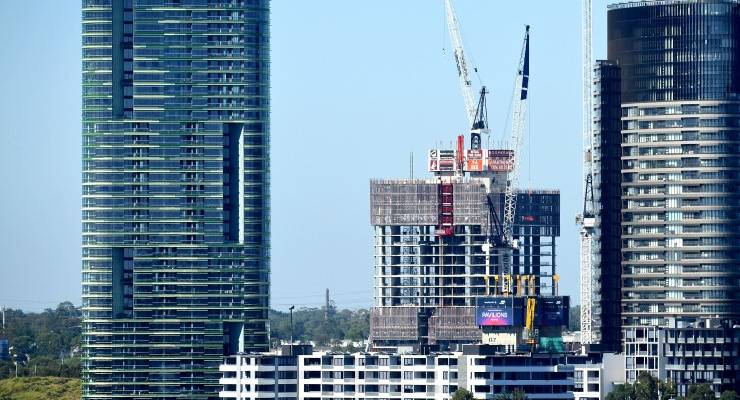
While debate over future immigration levels continues to simmer, yesterday the Master Builders Association (MBA) provided a small glimpse of what the economic future might look like with lower levels of new arrivals and less demand for housing.
The MBA has overhauled its industry forecasts to take into account the impact on forward contracts of the pandemic. As with any industry group, the MBA has an incentive to catastrophise the coming contraction, but its numbers are far more grounded in reality than the usual industry propaganda pieces (such as the Minerals Council trying to claim that coal mining was a “major employer”).
Pre-pandemic, the MBA had forecast that, after a bad year in 2019, growth in the whole construction sector would tick over at around 1% a year into the mid-2020s.
Forecasts for new home building have now been downgraded by 27% in 2020-21 and over 20% a year until 2024, meaning that home building in 2024 will still be around 10% below 2018-19 levels.
Commercial building forecasts have been downgraded around 16% in 2020-21, 11.5% in 2021-22 and in single digit figures after that. In 2024, commercial building activity will still be around 12% below current levels.
The result will be hundreds of thousands of fewer construction jobs over the next four years. Sector employment currently totals around 1.19 million people and which is the third largest source of jobs in the economy.
As the MBA notes, the residential construction sector was already struggling before the pandemic. ABS data shows residential construction down a whopping 14.4% over the course of 2019 in seasonally adjusted terms. Apartment construction was the culprit: that was down more than a fifth — yes, 22% — over 2019.
The smaller non-residential building sub-sector still performed solidly with 3.7% growth, but commercial building is facing bleak time with major development deals falling over and big questions about how much office and retail space CBDs will need in a COVID-19 world of social distancing, telecommuting and reluctant consumers.
For residential construction, especially apartment construction, the pause in immigration and the likely reduction in foreign student numbers means the MBA’s forecast that residential construction will bottom out next year and then begin a slow recovery might yet prove optimistic. As it is, the sector could materially drag down employment and economic growth until the mid-2020s.
The MBA and the CFMEU — who are normally at each others’ throats — have jointly called for a $10 billion government investment in tens of thousands of social housing dwellings to support residential construction, echoing calls from social services NGOs.
Social housing was a major part of the Rudd government’s successful stimulus program a decade ago, though Labor governments in NSW and Victoria subsequently cut their own investment in social housing, leaving little in the way of lasting legacy.
Construction has been ostensibly unaffected by the pandemic lockdown, with the industry able to continue working and projects at both residential and commercial level proceeding as normal.
The pessimistic projections reflect the way in which the lingering impacts of the pandemic, and particularly its blow to consumer and business confidence, could when combined with an already stagnant industry, produce a more traditional recession than the deliberately induced stoppage we’re now emerging from.
In an economic statement to parliament today, Treasurer Josh Frydenberg provided some short-term forecasts around the impact of the pandemic. Gross domestic product is expected to contract over 10%, and unemployment to reach around 10%, in the June quarter. Household consumption is forecast to be 16% lower, business investment 18% lower and housing investment down 18%.
Frydenberg also noted that household savings were expected to increase, which will undermine economic growth going forward (growth was already stagnant due to the government’s wage stagnation policies).
The treasurer offered no deficit forecast but noted that to the end of March, the underlying cash deficit was $22.4 billion, $9.9 billion higher than the government’s forecast for that stage at the end of 2019.








Any chance this means the awful self certification will go and buildings will be built properly once again?
Keane might need to consult a calendar – a decade ago, in 2010, Krudd ceased to be PM and in early 2011 “Labor” lost government in NSW.
So how did his reflexively bete noir party “Labor governments in NSW & Victoria subsequently cut their own investment in social housing“?
“Labor” didn’t become the government of Victoria until 2014, a year after Toned Abbs became PM.
He’s becoming a bit of an embarrassment with such sloppy one eyed partisan claptrap.
Never lets the facts get in the way of a neolib idee fix.
I’m not sure that a pause or decline in the construction of sub-standard death traps is anything to mourn, despite any negative economic impact it may entail.
Now we see how chasing endless growth is going to backfire. We got the warning in 2008. Governments of both Liberal and Labour facilitated laid back immigration schemes using “best practice” planning. They continued their ignorance with chants like “jobs and growth, jobs and growth.” Australians will now suffer the consequences. Unless we encourage new political parties any return to normal will bypass at least a generation.
“with lower levels of new arrivals and less demand for housing.”
Does anything quite define pointlessness better than requiring high immigration so we can have a bouyant construction sector, that builds shoddy buildings.
The obverse of this is the neoliberal mantra that the way to bring down house prices was to build more houses, supply and demand they said, whilst ensuring that demand was way beyond sustainable.
What a bereft polity we live in. Al. Major cities become unlivable so we can prop up a construction sector. Almost as stupid as propping up a dying, low employment coal sector so that we can make profits that are sent to overseas investors. Brain-dead.